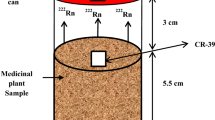Abstract
THE radioactive gas radon-222, produced by the decay of radium-226, diffuses from the ground and is transported by atmospheric turbulence far from its origin through the troposphere and into the stratosphere1. The radioactive decay of radon-222 and its short-lived descendants produces measurable quantities of lead-210 in the atmosphere1–3. Lead atoms so formed become attached to dust particles and eventually return to the Earth's surface, principally in rainfall1,4,5. Hill's4 report of a correlation coefficient of 0.87 between the quantity of rainfall and the concentration of lead-210 in grass clearly indicates a linear relationship. Holtzman6 reported a relationship between the concentration of lead-210 in the human skeleton and in the atmosphere. Whether the lead-210 enters the body principally through precipitation on foodstuffs that are later eaten5 or through direct inhalation, or by both means7, is at present uncertain. It is therefore feasible to view the occurrence of lead-210 as a “natural fall-out” product, similar, in this respect, to fission product fall-out, artificially produced from a nuclear detonation. In fact, very strong similarities between lead-210 and fission product activities have been reported with respect to their behaviour in the atmosphere1, to their rate and mode of deposition1,5, and to their concentration in grasses4. The similarities between lead-210 and fission product activities do not imply any relationship in their production. The formation of lead-210 in nuclear weapons explosions is improbable, and if any were so formed it would be negligible in comparison with the amount formed by natural processes8. The observed similarities between lead-210 and fall-out are caused by their similar behaviour in the atmosphere.
This is a preview of subscription content, access via your institution
Access options
Subscribe to this journal
Receive 51 print issues and online access
$199.00 per year
only $3.90 per issue
Buy this article
- Purchase on Springer Link
- Instant access to full article PDF
Prices may be subject to local taxes which are calculated during checkout
Similar content being viewed by others
References
Burton, W. M., and Stewart, N. G., Nature, 186, 584 (1960).
Osborne, R. V., Nature, 199, 143 (1963).
Patterson, R. L., and Lockhart, L. B., The Natural Radiation Environment, edit. by Adams, J. A. S., and Lowder, W. M., 383 (University of Chicago Press, 1964).
Hill, C. R., Nature, 187, 211 (1960).
Hill, C. R., “Po210: A Naturally Occurring Component of ‘Fallout’,” presented at a symposium on “Radioactivity in Scandinavia”, Denmark (October 1964).
Holtzman, R. B., Health Physics, 11, 477 (1965).
Holtzman, R. B., Health Physics, 9, 385 (1963).
Hill, C. R. (to be published).
Gaffney, G. W., Hallisey, R. M., Miller, M. S., and Goldin, A. S., Radiat. Health Data, 5, 620 (1964).
Robbins, M. C., LA–1904 (1955).
Blanchard, R. L., Anal. Chem., 38, 189 (1966).
Hillebrand, W. F., and Lundell, G. E. F., Applied Inorganic Analysis, 627 (Wiley, New York, 1959).
Archibald, J. G., Dairy Sci. Abstr., 20, 801 (1958).
ICRP—Report of Committee II, Health Phys., 3, 133 (1960).
Groos, V. E., Sattler, E. L., and Stahlhofen, W., Atomkernenergia, 8, 32 (1963).
Osborne, R. V., Nature, 199, 295 (1963).
Black, S. C. (unpublished data).
Sowby, F. D. (personal communication).
Author information
Authors and Affiliations
Rights and permissions
About this article
Cite this article
BLANCHARD, R. Correlation of Lead-210 with Strontium-90 in Human Bones. Nature 211, 995–996 (1966). https://doi.org/10.1038/211995a0
Issue Date:
DOI: https://doi.org/10.1038/211995a0
This article is cited by
-
Radioactive isotope analyses of skeletal materials in forensic science: a review of uses and potential uses
International Journal of Legal Medicine (2014)
Comments
By submitting a comment you agree to abide by our Terms and Community Guidelines. If you find something abusive or that does not comply with our terms or guidelines please flag it as inappropriate.



